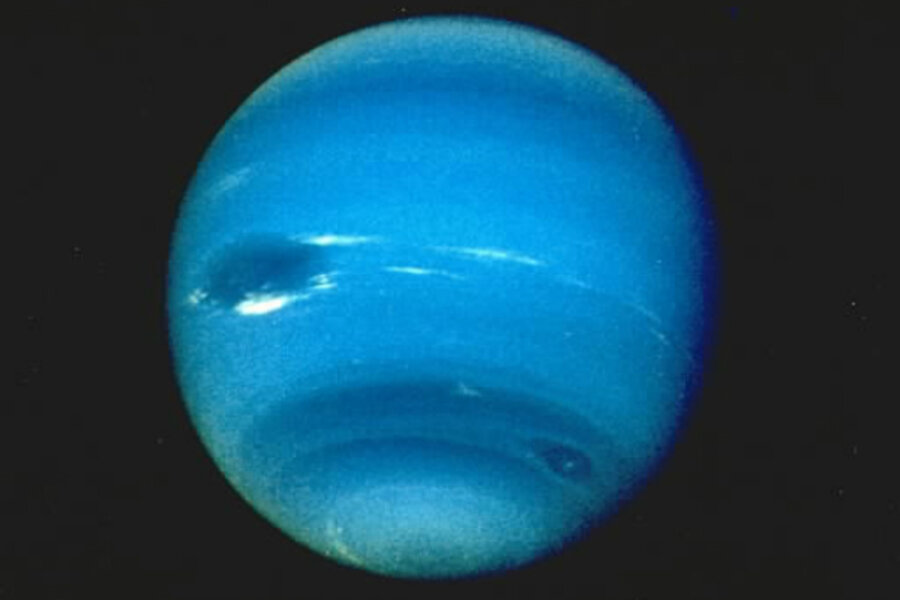Why do planets farthest from sun have highest winds? Team closes in on answer
Loading...
Astronomers have long marveled that the fastest wind speeds in the solar system have been clocked on the planets farthest from the sun.
Now, they may be a step closer to figuring out the energy source that drives these mighty winds.
In a new study, a team of scientists from Israel and the US finds that on Uranus and Neptune the winds appear to be confined to the top 680 miles of the atmosphere – and may actually involve a thinner layer than that.
The results not only reveal new information about Uranus and Neptune, the researchers say. They also provide insights into the mechanisms driving the atmospheres of planets orbiting other stars, says William Hubbard, a researcher at the University of Arizona's Lunar and Planetary Laboratory and a member of the team reporting the results in Thursday's issue of the journal Nature.
Up to now, researchers have posited two possible sources: processes confined to the top layer of the atmosphere or heat welling up from deep in the planets' interiors. Both planets emit more heat than they receive from the sun, with Neptune radiating twice as much. And while 680 miles of atmosphere seems towering by Earthly standards, it's only skin deep for Uranus and Neptune.
The winds in the planets' wide equatorial jet streams rip along at speeds of up to 450 miles an hour on Uranus and as high as 1,300 miles an hour on more-distant Neptune. Still, the flows "seem to be rather shallow, so the amount of energy that has to be supplied to keep them going is much less than might have been thought," Dr. Hubbard says.
The planets beyond Mars exhibit the highest winds speeds of any other planets in the solar system. Yet from Jupiter on out, wind speeds increase with distance, even though less energy is available from the sun to drive atmospheric circulation at each orbit along the way.
The reasons for this trend "are not well understood, actually," says Adam Showman, also with the Lunar and Planetary Laboratory and a member of the study's team. But the prime suspect is atmospheric drag, or rather, the lack of it.
The outer planets' atmospheres behave more like liquids deep in their interiors, so there is virtually no surface roughness to act as a drag on winds, as there is on Earth. And as the distance between a planet and the sun increases, there is less solar energy to impart turbulence to the atmosphere, which also acts as a drag.
So even though the energy reaching the planets is weak, "the drag is even weaker, and therefore the winds are faster," Dr. Showman says.
That still leave open the question of where the winds get their energy, and how deeply the winds penetrate into the atmosphere hold an important clue to that puzzle.
Voyager 2 took photos of the two planets as it sped by them and made other measurements, but it had no way to measure the winds or how deep they reach into the atmospheres of the two planets.
So the team, led by Yohai Kaspi, of the Weizmann Institute of Science in Israel, tapped an approach that has been used to study other planetary interiors for decades: measuring a planet's gravity field.
"The interior structure of a planet and the detailed distribution of [its] mass tells you a lot about what the planet is doing, Showman explains. "That distribution of mass affects the gravity field."
For gas giants like Jupiter and the other outer planets, their atmospheres are so thick that they represent the lion's share of the planets' masses.
In the early 1990s, Dr. Hubbard suspected the same might be true for the gas giants, whose large-scale atmospheric circulation features affect the atmosphere's density in their vicinity, which should show up as subtle changes in a planet's gravity field. The larger the feature, the more pronounced its imprint on the gravity field would be.
Analyzing data from Jupiter, he got hints that the technique worked. Subsequent research provided enough of a proof of concept that NASA now has the JUNO mission heading to Jupiter to map the planet's gravity field with enough precision to use the data as a probe of atmospheric features in a broad range of size scales.
The JUNO orbiter was launched in August 2011 and is expected to arrive at Jupiter in July 2016.
After crunching the numbers for JUNO, the team realized that the wind features on Uranus and Neptune are so large that the somewhat fuzzy view Voyager amassed of the two planets' gravity fields might still be good enough to reveal information on the depth of the winds. That indeed proved to be the case.
As for possible energy sources, the sun may play a small role, but the main driver may lie not deep in the planet's interior, but near the base of the jet streams themselves.
On Neptune, which emits twice as much energy as it receives from the sun, the researchers suggest that the heat driving the winds could come as water vapor in the atmosphere condenses into clouds. Condensation releases the heat required to turn it the water into into vapor in the first place.
The heat that evaporated the water represents heat left over from the planet's formation, the researchers suggest.
Uranus, on the other hand, present something of a puzzle because while it, too, radiates more energy that it receives, it's only about 10 percent more, Showman says.







